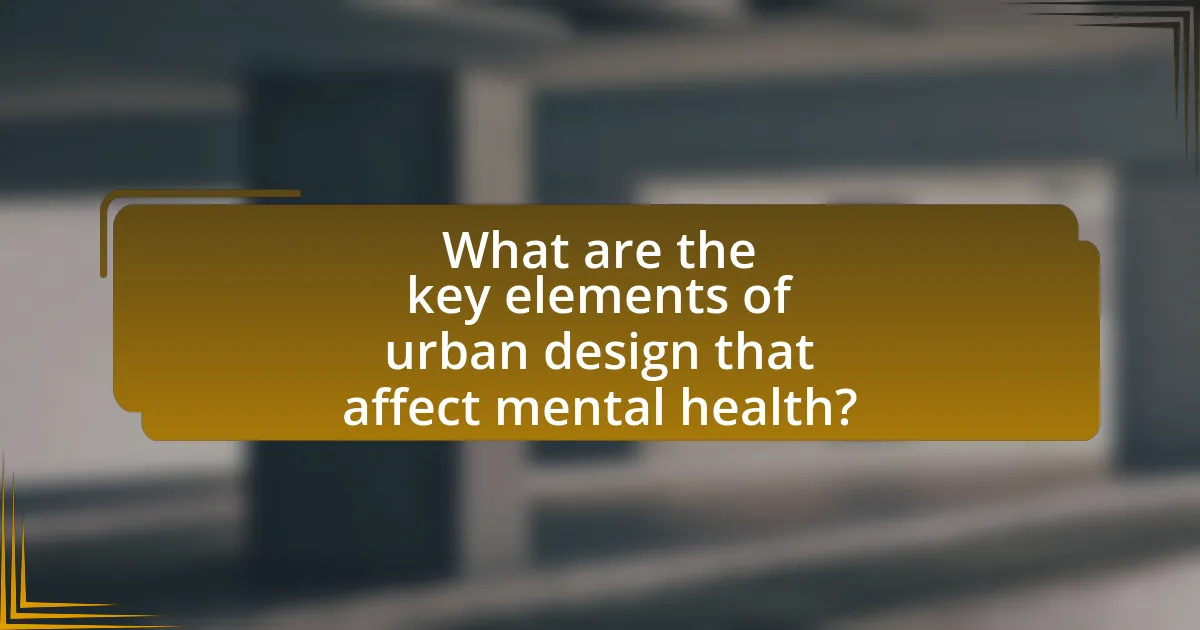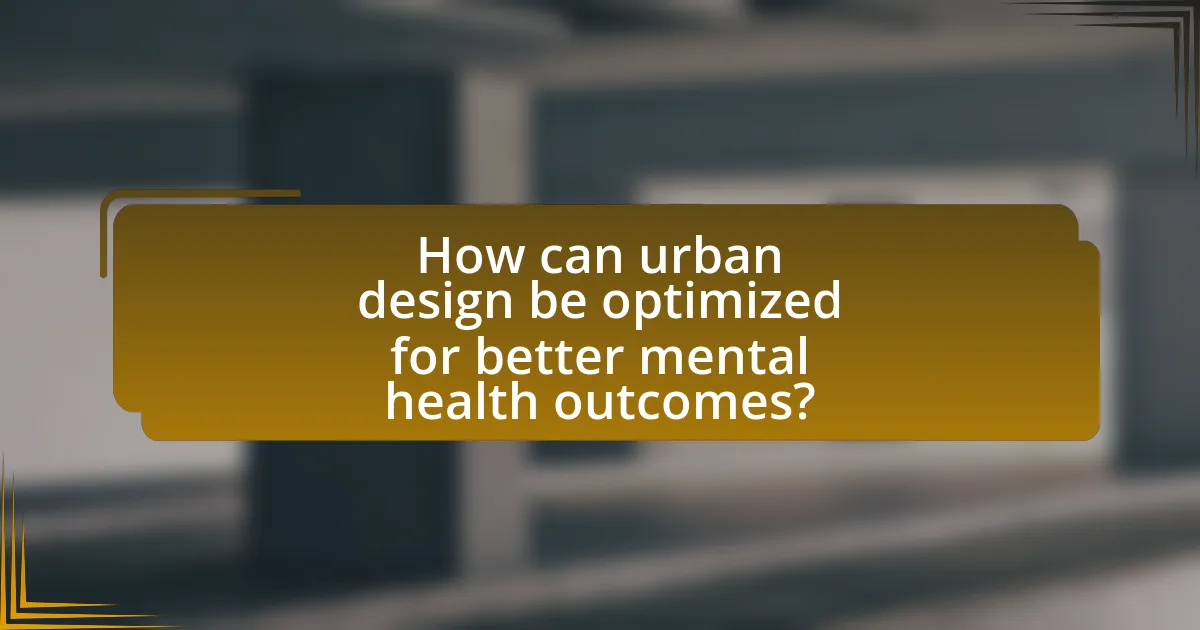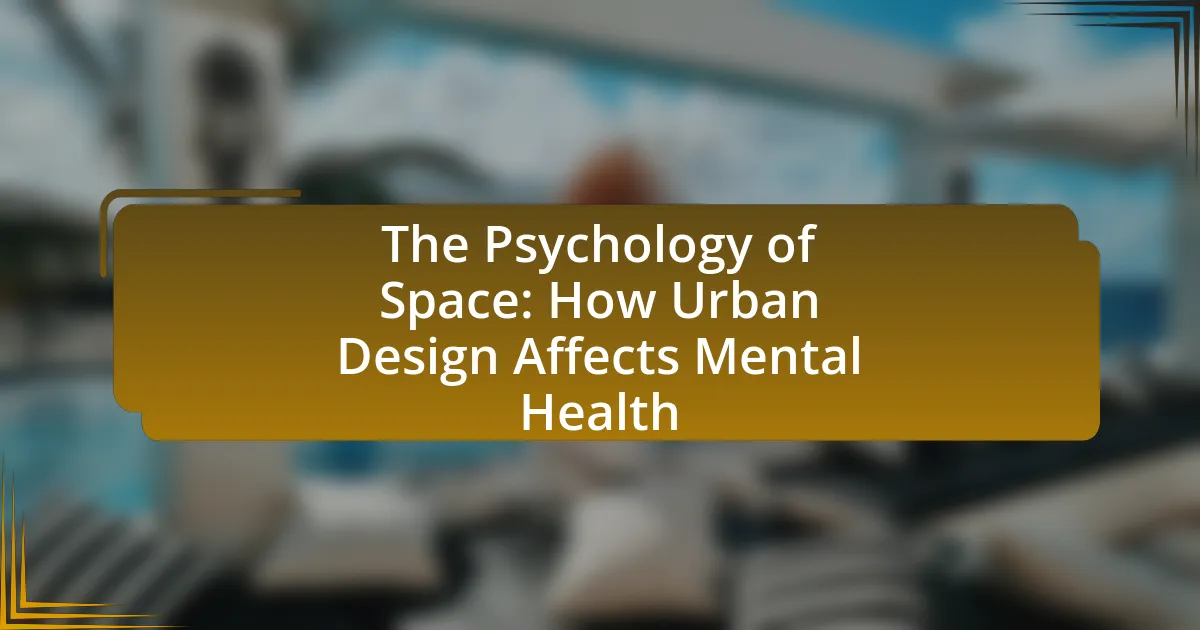The article explores the psychology of space in urban design, emphasizing how physical environments influence human behavior, emotions, and social interactions. It highlights the importance of well-designed urban spaces in enhancing mental well-being by promoting social interaction, reducing stress, and encouraging physical activity. Key elements such as green spaces, walkability, and community resources are discussed, along with psychological theories that explain their impact on mental health. The article also examines the implications for urban planners and designers, providing insights into how thoughtful urban design can lead to improved community health outcomes and overall psychological well-being.

What is the Psychology of Space in Urban Design?
The psychology of space in urban design refers to how the physical environment influences human behavior, emotions, and social interactions. This concept is grounded in environmental psychology, which studies the relationship between individuals and their surroundings. Research indicates that well-designed urban spaces can enhance mental well-being by promoting social interaction, reducing stress, and encouraging physical activity. For instance, a study published in the journal “Environment and Behavior” found that access to green spaces significantly improves mood and reduces anxiety levels among urban residents. Thus, the psychology of space is crucial in creating urban environments that support mental health and foster community engagement.
How does urban design influence mental health?
Urban design significantly influences mental health by shaping the environments in which people live, work, and interact. Well-designed urban spaces can promote social interaction, physical activity, and access to nature, all of which are linked to improved mental well-being. For instance, research published in the journal “Environmental Science & Technology” by Kuo and Sullivan (2001) found that access to green spaces reduces stress and enhances mood. Additionally, urban areas that prioritize walkability and community spaces foster social connections, which are crucial for mental health. Conversely, poorly designed urban environments can lead to feelings of isolation, anxiety, and depression, as evidenced by studies indicating that high-density living without adequate public spaces can negatively impact residents’ mental health.
What psychological theories explain the relationship between space and mental well-being?
Psychological theories that explain the relationship between space and mental well-being include Environmental Psychology, which posits that physical environments significantly influence emotional states and behaviors. This theory is supported by research indicating that natural environments can reduce stress and enhance mood, as shown in studies like Kaplan and Kaplan’s Attention Restoration Theory, which suggests that exposure to nature aids cognitive restoration and improves mental health. Additionally, the concept of Place Attachment highlights how emotional bonds to specific spaces can foster a sense of belonging and well-being, as evidenced by studies demonstrating that individuals with strong place attachment report higher life satisfaction. These theories collectively illustrate how spatial design and environmental factors are crucial in shaping mental health outcomes.
How do different urban environments impact emotional responses?
Different urban environments significantly impact emotional responses by influencing feelings of safety, community, and well-being. For instance, green spaces in urban areas have been shown to reduce stress and enhance mood, as evidenced by a study published in the journal “Environmental Science & Technology,” which found that individuals living near parks reported lower levels of anxiety and depression. Conversely, densely populated urban settings with high levels of noise and pollution can lead to increased stress and feelings of isolation, as highlighted in research from the “Journal of Urban Health,” which indicates that urban noise correlates with higher rates of mental health issues. Thus, the design and characteristics of urban environments play a crucial role in shaping emotional well-being.
Why is understanding the psychology of space important?
Understanding the psychology of space is important because it directly influences human behavior, emotions, and mental health. Research indicates that the design and organization of physical environments can significantly affect stress levels, social interactions, and overall well-being. For instance, studies have shown that access to green spaces can reduce anxiety and improve mood, while poorly designed urban areas may contribute to feelings of isolation and depression. Therefore, recognizing how spatial elements impact psychological states is crucial for creating environments that promote mental health and enhance quality of life.
What are the implications for urban planners and designers?
Urban planners and designers must prioritize mental health in their projects, as urban design significantly influences psychological well-being. Research indicates that well-designed public spaces can reduce stress and promote social interaction, which are crucial for mental health. For instance, a study published in the Journal of Environmental Psychology found that access to green spaces is linked to lower levels of anxiety and depression. Therefore, urban planners should incorporate natural elements, community spaces, and pedestrian-friendly designs to enhance the mental health of urban populations.
How can this understanding improve community health outcomes?
Understanding the relationship between urban design and mental health can significantly improve community health outcomes by fostering environments that promote well-being. Research indicates that well-designed public spaces, such as parks and community centers, can reduce stress and enhance social interaction, leading to improved mental health. For instance, a study published in the Journal of Environmental Psychology found that access to green spaces is associated with lower levels of anxiety and depression among urban residents. By prioritizing mental health in urban planning, communities can create supportive environments that encourage physical activity, social cohesion, and overall well-being, ultimately leading to healthier populations.

What are the key elements of urban design that affect mental health?
Key elements of urban design that affect mental health include green spaces, walkability, social interaction opportunities, and safety. Green spaces, such as parks and gardens, have been shown to reduce stress and improve mood, as evidenced by a study published in the Journal of Environmental Psychology, which found that access to nature can enhance psychological well-being. Walkability promotes physical activity and social engagement, contributing to lower rates of anxiety and depression; research from the American Journal of Preventive Medicine indicates that walkable neighborhoods correlate with better mental health outcomes. Opportunities for social interaction, such as communal areas and public gathering spaces, foster community ties and support networks, which are crucial for mental health, as highlighted in a study by the National Institute of Mental Health. Lastly, safety in urban environments, including well-lit streets and low crime rates, is essential for mental well-being; the World Health Organization emphasizes that perceived safety can significantly influence mental health.
How do green spaces contribute to psychological well-being?
Green spaces contribute to psychological well-being by providing environments that reduce stress, enhance mood, and promote overall mental health. Research indicates that exposure to natural settings can lower cortisol levels, which are associated with stress, and improve feelings of relaxation and happiness. A study published in the journal “Environmental Science & Technology” found that individuals living near green spaces reported better mental health outcomes, including lower rates of anxiety and depression. Furthermore, engaging in activities within these spaces, such as walking or socializing, fosters community connections and physical activity, both of which are beneficial for mental well-being.
What types of green spaces are most beneficial for mental health?
Parks, gardens, and natural reserves are the types of green spaces most beneficial for mental health. Research indicates that exposure to these environments can significantly reduce stress, anxiety, and depression. For instance, a study published in the journal “Environmental Science & Technology” found that individuals who spent time in green spaces reported lower levels of psychological distress and improved mood. Additionally, urban parks provide opportunities for social interaction and physical activity, both of which are linked to enhanced mental well-being.
How does access to nature influence stress levels?
Access to nature significantly reduces stress levels. Studies indicate that exposure to natural environments can lower cortisol levels, which is a primary stress hormone. For instance, research published in the Journal of Environmental Psychology found that individuals who spent time in green spaces reported lower levels of perceived stress and anxiety compared to those in urban settings. Additionally, a meta-analysis conducted by Bratman et al. (2015) demonstrated that nature exposure is associated with improved mood and cognitive function, further supporting the notion that access to nature plays a crucial role in stress reduction.
What role does urban density play in mental health?
Urban density significantly influences mental health by affecting social interactions, access to resources, and exposure to stressors. High urban density can lead to increased social isolation, as individuals may feel overwhelmed by crowds and noise, which can exacerbate anxiety and depression. Conversely, moderate urban density can foster community engagement and support networks, promoting better mental well-being. Research indicates that densely populated areas often experience higher rates of mental health issues, with studies showing that urban residents are more likely to report psychological distress compared to those in less populated areas. For instance, a study published in the journal “Environmental Health Perspectives” found that individuals living in high-density urban environments exhibited increased levels of stress and anxiety, highlighting the complex relationship between urban density and mental health outcomes.
How can high-density living environments affect social interactions?
High-density living environments can enhance social interactions by facilitating increased opportunities for community engagement and social networking. In densely populated areas, residents are more likely to encounter neighbors and engage in communal activities, which can lead to stronger social ties. Research indicates that urban areas with higher population densities often have more public spaces, such as parks and community centers, which serve as venues for social interaction. For example, a study published in the Journal of Urban Affairs found that neighborhoods with greater density and mixed-use developments fostered higher levels of social cohesion and community involvement. This suggests that the design and density of living environments play a crucial role in shaping social dynamics and interactions among residents.
What are the mental health challenges associated with urban overcrowding?
Urban overcrowding leads to significant mental health challenges, including increased anxiety, depression, and stress. The high population density often results in limited personal space, which can exacerbate feelings of claustrophobia and social isolation. Research indicates that individuals living in overcrowded conditions are more likely to experience psychological distress, with studies showing a correlation between high-density living and elevated levels of mental health issues. For instance, a study published in the Journal of Urban Health found that urban residents in densely populated areas reported higher rates of anxiety and mood disorders compared to those in less crowded environments. Additionally, overcrowding can strain community resources, leading to increased competition for jobs and housing, further contributing to mental health deterioration.

How can urban design be optimized for better mental health outcomes?
Urban design can be optimized for better mental health outcomes by incorporating green spaces, promoting walkability, and ensuring access to community resources. Research indicates that exposure to nature reduces stress and enhances mood; for instance, a study published in the Journal of Environmental Psychology found that individuals who spent time in green environments reported lower levels of anxiety and depression. Additionally, designing neighborhoods that encourage walking and cycling can improve physical health and social interaction, both of which are linked to better mental well-being. A report from the American Journal of Public Health highlighted that walkable neighborhoods lead to increased physical activity, which is associated with lower rates of mental health issues. Lastly, ensuring that urban areas have accessible community centers and mental health services can provide essential support, as evidenced by findings from the World Health Organization, which emphasize the importance of social support in mental health.
What design strategies can enhance psychological well-being in cities?
Design strategies that can enhance psychological well-being in cities include the incorporation of green spaces, walkable neighborhoods, and community-oriented public spaces. Green spaces, such as parks and gardens, have been shown to reduce stress and improve mood, as evidenced by a study published in the journal “Environmental Science & Technology,” which found that individuals living near green areas reported better mental health outcomes. Walkable neighborhoods promote physical activity and social interaction, contributing to overall well-being; research from the “American Journal of Preventive Medicine” indicates that walkability is linked to lower rates of depression and anxiety. Additionally, designing public spaces that encourage community engagement fosters social connections, which are crucial for mental health, as highlighted in the “Journal of Urban Design,” where studies demonstrate that vibrant public spaces lead to increased social cohesion and improved psychological health.
How can walkability and accessibility improve mental health?
Walkability and accessibility can significantly improve mental health by promoting physical activity, social interaction, and reducing stress. Research indicates that environments designed for walking encourage individuals to engage in regular exercise, which is linked to lower levels of anxiety and depression. A study published in the Journal of Environmental Psychology found that people living in walkable neighborhoods reported higher levels of well-being and lower levels of mental distress. Additionally, accessible public spaces foster social connections, which are crucial for emotional support and community engagement, further enhancing mental health outcomes.
What are the benefits of mixed-use developments for community mental health?
Mixed-use developments significantly enhance community mental health by fostering social interaction and reducing isolation. These developments combine residential, commercial, and recreational spaces, creating vibrant environments where individuals can engage with one another. Research indicates that increased social interaction is linked to lower levels of anxiety and depression, as highlighted in a study published in the Journal of Urban Health, which found that neighborhoods with mixed-use designs promote community cohesion and support networks. Additionally, mixed-use developments often include green spaces, which have been shown to improve mental well-being by providing areas for relaxation and physical activity, further contributing to overall mental health benefits.
What are some successful case studies of urban design improving mental health?
Successful case studies of urban design improving mental health include the High Line in New York City and the revitalization of the Cheonggyecheon Stream in Seoul. The High Line, a linear park built on a former elevated railway, has been shown to enhance community well-being by providing green space, promoting social interaction, and reducing stress levels among visitors. A study published in the Journal of Urban Design found that the park increased physical activity and improved mental health outcomes for residents in the surrounding neighborhoods.
Similarly, the Cheonggyecheon Stream project transformed a congested highway into a vibrant public space, leading to increased biodiversity and improved air quality. Research conducted by the Seoul Development Institute indicated that this urban renewal project significantly boosted residents’ mental health by providing access to nature and recreational opportunities, which are essential for psychological well-being. These case studies demonstrate the positive impact of thoughtful urban design on mental health.
How have cities implemented design changes to promote mental well-being?
Cities have implemented design changes to promote mental well-being by integrating green spaces, enhancing walkability, and creating community hubs. For instance, urban areas like New York City have transformed underutilized spaces into parks, such as the High Line, which provides a natural environment that reduces stress and encourages social interaction. Research indicates that access to green spaces can lower anxiety and improve mood, with a study published in the journal “Environmental Science & Technology” showing that individuals living near parks report higher levels of happiness. Additionally, cities like Copenhagen have prioritized pedestrian-friendly infrastructure, which not only encourages physical activity but also fosters a sense of community, further contributing to improved mental health outcomes.
What lessons can be learned from these case studies?
The lessons learned from these case studies highlight the significant impact of urban design on mental health. Specifically, well-designed public spaces that promote social interaction and physical activity can lead to improved mental well-being. For instance, research indicates that access to green spaces reduces stress and enhances mood, as evidenced by a study published in the Journal of Environmental Psychology, which found that individuals living near parks reported lower levels of anxiety. Additionally, the case studies demonstrate that walkable neighborhoods foster community engagement, which is linked to higher levels of social support and lower rates of depression. These findings underscore the importance of integrating mental health considerations into urban planning and design.
What practical steps can urban planners take to support mental health?
Urban planners can support mental health by designing spaces that promote social interaction, access to nature, and safe environments. Incorporating parks, community gardens, and recreational areas encourages physical activity and social engagement, which are linked to improved mental well-being. Research indicates that green spaces can reduce stress and anxiety; for instance, a study published in the journal “Environmental Science & Technology” found that individuals living near parks reported lower levels of mental distress. Additionally, creating walkable neighborhoods with mixed-use developments fosters community connections and reduces isolation, further enhancing mental health outcomes. Implementing these strategies can lead to healthier urban environments that prioritize the psychological well-being of residents.
